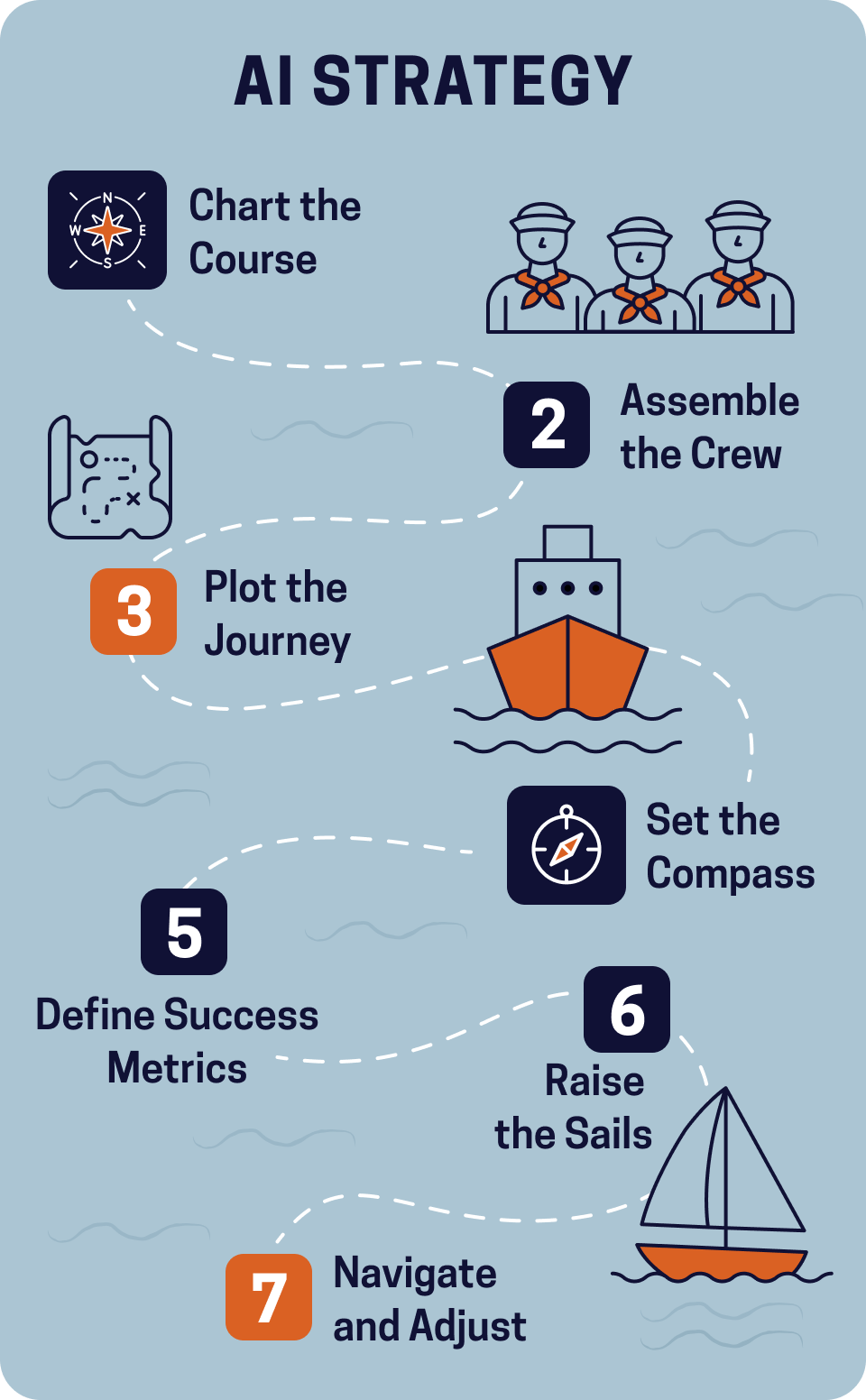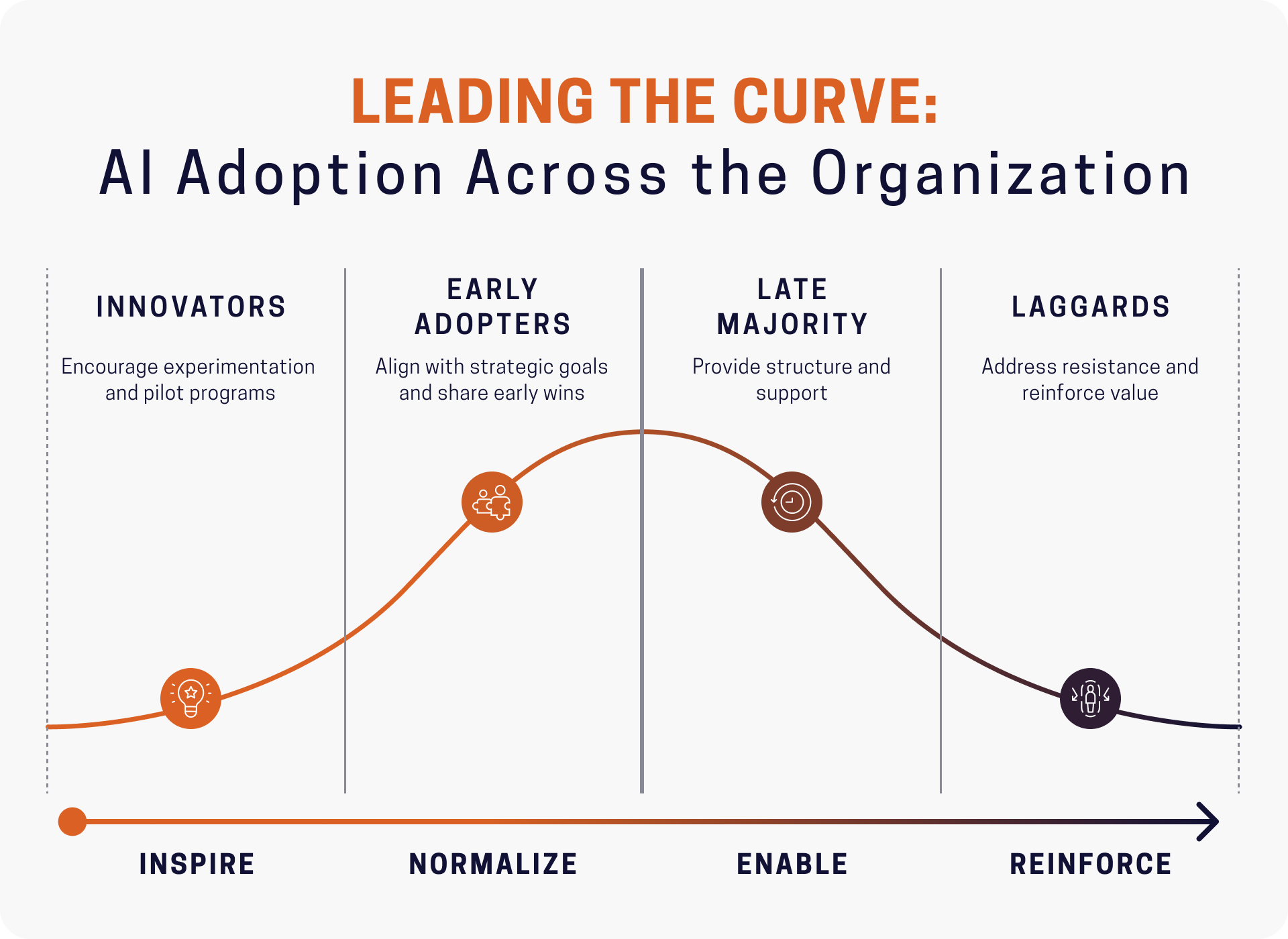Executives Have Never Been More Critical to AI Integration.
Before a ship can set sail, it must be seaworthy and have a clear destination. Many leaders today are rushing to set sail with AI, investing in tools before charting a course. In the rush to adopt new tools, they focus on the “what” instead of the “why,” driven more by market pressure or executive mandates than strategic intent. Without clarity, even the most advanced AI initiatives risk drifting off course, leading to friction, inefficiencies, and high premiums.
The Risk of Mandates Without Meaning
We talk to leaders every day who are eager to get their teams moving on AI, worried that if they don’t act, the waters will become too rough to navigate later. But in their haste, many are abandoning the very tools that have guided them through past transformations: clearly defined business problems, identified skill gaps, and evaluation of data and governance readiness.
Instead, we hear vague mandates like “go do AI” and “don’t fall behind,” as if hoisting the AI flag is enough to move the organization forward. It’s not. These top-down commands often lack context or intent, resulting in confusion on deck.
 Executives may think they’ve set a clear direction, but middle managers and frontline staff are left guessing. Work is duplicated, success is never defined, and valuable resources are wasted. The churn affects the operating rhythm, slows adoption rates, and creates pushback, making AI harder to integrate than it should be.
Executives may think they’ve set a clear direction, but middle managers and frontline staff are left guessing. Work is duplicated, success is never defined, and valuable resources are wasted. The churn affects the operating rhythm, slows adoption rates, and creates pushback, making AI harder to integrate than it should be.
Without a clear destination, even the best-equipped AI efforts will drift off course. The result isn’t organizational transformation; it’s a scramble to stay afloat.
Before leaders hand down AI mandates, they must pause and reflect:
- What business problem are we solving?
- What skills are missing from our crew?
- Are data and governance frameworks ready?
AI is not plug-and-play. It’s not something you pick off a shelf and drop in to place. It requires learning: how to leverage new tools, how to lead in this rapidly changing landscape, and how to make smart choices amid a flood of options. Clarity of intent matters more than speed of adoption. Without it, you’re not leading AI integration; you’re drifting off course.
You’re Already Using AI. You Just Haven’t Owned It.
If you don’t have an AI integration strategy, your team is likely developing one without you.
Many leaders are surprised to learn AI integration is already underway inside their organization. Marketing teams are using generative AI to build campaigns and content. HR is testing tools to streamline job descriptions and performance reviews. Operations is exploring automation to reduce repetitive tasks. These grassroots efforts are fast, creative, and often effective, but they’re often happening in the shadows without a formal strategy, defined metrics, or leadership guidance.
Without clear direction, frontline teams push forward. IT and security push back. Leadership sends mixed messages. The result? Confusion, duplication, and misalignment with organizational goals and polices.
The deeper truth? This isn’t a digital problem. It’s an alignment problem. A Team of Teams® problem.
Too often, the C-suite issues broad mandates without defining the problem or identifying the stakeholders involved. Meanwhile, the teams closest to the work are already experimenting out of necessity, not strategy.
The most effective AI efforts today come from the convergence of these two forces:
- Executive vision that sets intent and direction
- Frontline innovation born from real pain points or opportunities
When these forces align, AI adoption becomes systemic, not siloed. That’s where the real momentum starts.
So where do you start?
- Map what’s already happening. Identify where AI is being leveraged. Who’s driving it? And why?
- Identify your internal innovators. These early adopters are your lookouts for the voyage ahead.
- Build a cross-functional coalition. Bring together IT, compliance, business unit leads, and frontline innovators to co-create a course that balances innovation with security, speed, and governance.
You’re not starting from zero. But without a clear picture of what’s already underway, you risk building a strategy that overlooks your most valuable insights and your biggest risks.

Lead Like a Gardener, Not a Technician.
Strategy sets the direction. Culture determines the speed.
While technical expertise in AI is important, it’s not where leadership should focus first. The real challenge lies in leading people through unfamiliar territory. You don’t need to become a programmer or a prompt engineer overnight, but you do need to lead with clarity, courage, and intent.
As an executive, your job is to cultivate the right conditions for cultural growth. Lead like a gardener: plant seeds of trust, nurture with knowledge, and provide light for innovation. When your people are aligned, supported, and inspired, they’ll find creative, responsible ways to bring AI to life across the business.
This is the cultural shift that unlocks real adoption. It requires leaders at every level to model transparency, empower experimentation, and communicate openly about the risks and opportunities that AI presents.
To lead well in this moment, every member of the executive team must step up.
Chart the Course of AI Integration Together.
AI isn’t a single transformation. It’s a series of choices that, over time, shape a new way of operating. It’s not about rushing towards new horizons; it’s about navigating them with intent.
Before you raise the sails, make sure your crew is aligned on the destination, the risks, and the rules of the voyage. AI integration is a Team of Teams® effort, blending executive clarity with frontline insight, tech infrastructure with human empathy, and bold ambition with shared accountability.
The map won’t be perfect. The seas will shift. But if you lead with purpose and align your people, culture, and systems, you won’t drift. You’ll move forward, together.




